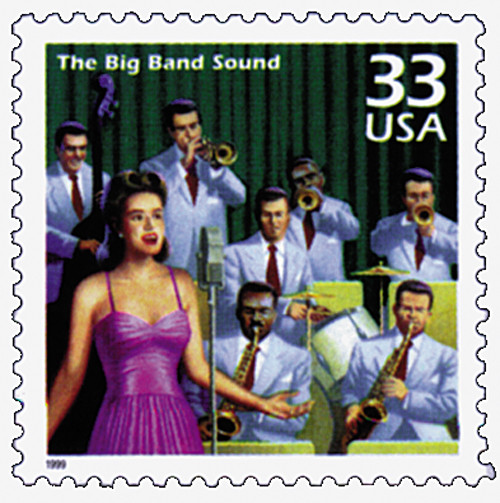
1999 33c Celebrate the Century,1940s: Jitterbug Sweeps Nation
# 3186g - 1999 33c Celebrate the Century - 1940s: Jitterbug Sweeps Nation
$1.95 - $3.20
U.S. #3186g
33¢ Jitterbug Sweeps Nation
Celebrate the Century – 1940s
33¢ Jitterbug Sweeps Nation
Celebrate the Century – 1940s
Issue Date: February 18, 1999
City: Dobbins AFB, GA
Printing Method: Lithographed, engraved
Perforations: 11.5
Color: Multicolored
City: Dobbins AFB, GA
Printing Method: Lithographed, engraved
Perforations: 11.5
Color: Multicolored
In 1928, the Lindy hop became a tremendously popular dance in the United States. Named in recognition of Charles Lindbergh’s solo flight across the Atlantic Ocean one year earlier, it was characterized by acrobatic swings and powerful lifts. In the 1930s and 1940s, the Lindy gained fame and became known as the jitterbug.
Films, newsreels, radio, records, movie stars, as well as exuberant teenagers all contributed to the spread of the jitterbug. Members of the U.S. military also helped make this dance so wildly popular worldwide.
As big band “swing” music became faster and louder, the jitterbug was taken to dramatic levels. A typical jitterbug “shag” session would involve women being spun and tossed in the air like limp ragdolls. A newspaper article of the time read, “There are no half-way measures with the true swing addicts. They give all they’ve got and let themselves go to the limit. Most of them invent new steps as they go along, with the music providing the inspiration.” Another article referred to a dance session as “wild hysteria.”
By the 1960s, the jitterbug had faded. In the 1970s, the dance was brought back in a version called the hustle. Jitterbug-style dancing and “swing” music became popular again in the late 1990s.
U.S. #3186g
33¢ Jitterbug Sweeps Nation
Celebrate the Century – 1940s
33¢ Jitterbug Sweeps Nation
Celebrate the Century – 1940s
Issue Date: February 18, 1999
City: Dobbins AFB, GA
Printing Method: Lithographed, engraved
Perforations: 11.5
Color: Multicolored
City: Dobbins AFB, GA
Printing Method: Lithographed, engraved
Perforations: 11.5
Color: Multicolored
In 1928, the Lindy hop became a tremendously popular dance in the United States. Named in recognition of Charles Lindbergh’s solo flight across the Atlantic Ocean one year earlier, it was characterized by acrobatic swings and powerful lifts. In the 1930s and 1940s, the Lindy gained fame and became known as the jitterbug.
Films, newsreels, radio, records, movie stars, as well as exuberant teenagers all contributed to the spread of the jitterbug. Members of the U.S. military also helped make this dance so wildly popular worldwide.
As big band “swing” music became faster and louder, the jitterbug was taken to dramatic levels. A typical jitterbug “shag” session would involve women being spun and tossed in the air like limp ragdolls. A newspaper article of the time read, “There are no half-way measures with the true swing addicts. They give all they’ve got and let themselves go to the limit. Most of them invent new steps as they go along, with the music providing the inspiration.” Another article referred to a dance session as “wild hysteria.”
By the 1960s, the jitterbug had faded. In the 1970s, the dance was brought back in a version called the hustle. Jitterbug-style dancing and “swing” music became popular again in the late 1990s.










